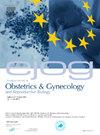Prevalence and sociodemographic distribution of endometriosis symptoms and indicators in Denmark
IF 2.1
4区 医学
Q2 OBSTETRICS & GYNECOLOGY
European journal of obstetrics, gynecology, and reproductive biology
Pub Date : 2025-01-31
DOI:10.1016/j.ejogrb.2025.01.051
引用次数: 0
Abstract
Introduction
Endometriosis is characterized by a range of non-specific symptoms which may contribute to the significant delay in diagnosis. Knowledge about the distribution of endometriosis symptoms across different geographical regions as well as other sociodemographic factors could add knowledge and guide initiatives to reduce this underdiagnosis. This study aims to explore how the prevalence of endometriosis symptoms and indicators are linked to the different sociodemographic factors.
Study design
The study used data from the CYKLUS-survey; a women’s health survey sent to 63,199 Danish women aged 16 to 51 in 2023. Self-reported information on endometriosis symptoms and indicators was linked to Danish register data on sociodemographic factors. Age-standardized prevalence of six endometriosis symptoms and indicators were estimated for each of the nine different regions of residence and for the whole country. In addition, logistic regression analysis was used to estimate the association between sociodemographic factors and the six endometriosis symptoms and indicators.
Results
11,407 women were included in the study. Age-standardized prevalence of symptoms showed little variation across Danish regions. However, younger age, lower socioeconomic status, and non-Danish origin were found to be associated with higher prevalences, and higher education was found to be associated with lower prevalences.
Conclusion
No major regional differences in endometriosis symptoms and indicators were found. However, associations were found between several sociodemographic factors and endometriosis symptoms and indicators, suggesting disparities in the burden of symptoms. These findings call for further investigation into factors causing these disparities in Denmark.
求助全文
约1分钟内获得全文
求助全文
来源期刊
CiteScore
4.60
自引率
3.80%
发文量
898
审稿时长
8.3 weeks
期刊介绍:
The European Journal of Obstetrics & Gynecology and Reproductive Biology is the leading general clinical journal covering the continent. It publishes peer reviewed original research articles, as well as a wide range of news, book reviews, biographical, historical and educational articles and a lively correspondence section. Fields covered include obstetrics, prenatal diagnosis, maternal-fetal medicine, perinatology, general gynecology, gynecologic oncology, uro-gynecology, reproductive medicine, infertility, reproductive endocrinology, sexual medicine and reproductive ethics. The European Journal of Obstetrics & Gynecology and Reproductive Biology provides a forum for scientific and clinical professional communication in obstetrics and gynecology throughout Europe and the world.

 求助内容:
求助内容: 应助结果提醒方式:
应助结果提醒方式:


